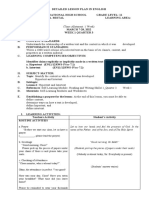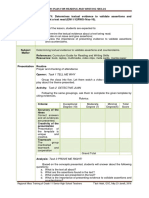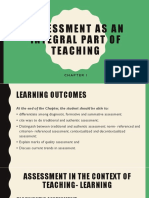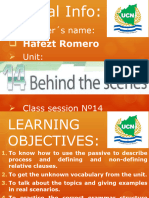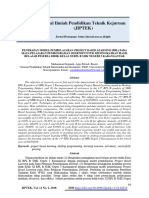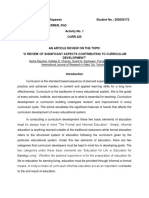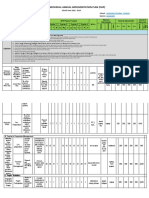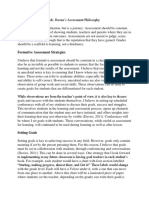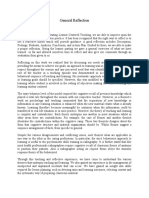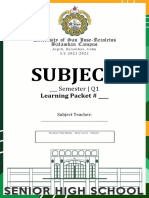Grades 1 Lambunao National High School
School Grade Level EPAS 11-A
to 12 (Senior High School)
DAILY Teacher PRECIOUS M. MODANZA Learning Area Reading and Writing Skills
LESSON PLAN Teaching Dates and November 28, 2019
Quarter First
Time 2:30 – 3:30 A.M.
I. OJECTIVES
A. Content Standards The learner realizes that information in a written text may be selected and organized to achieve a particular purpose.
The learner critiques a chosen sample of each pattern of development focusing on information selection,
B. Performance Standards
organization, and development.
The learner distinguishes between and among techniques in selecting and organizing information. EN11/12RWS-
C. Learning Competencies/
IIIa-2.2
Objectives
The learner recognizes a problem and creates their own problem-solution map.
II. CONTENT TECHNIQUES IN SELECTING AND ORGANIZING INFORMATION
(Graphic Organizer: Problem-Solution Map)
III. LEARNING RESOURCES COT INDICATORS
Barrot, J.S. (2017). Academic Reading and Writing for Senior High School. Quezon Selects, develops,
A. References organizes and uses
City: C&E Publishing, Inc.
appropriate teaching
B. Other Learning Resources
and learning resources,
C. Materials PowerPoint Presentation, Manila paper, marker, pictures including ICT, to
address learning goals
IV. PROCEDURES
REVIEW OF PAST LESSON
Have the learners analyze the graphic organizer shown on the slide. Ask them to name
the graphic organizer and discuss in what instance/s it can be used. Enhances numeracy
skills
1. (Network Tree)
Applies knowledge of
content within the
2. (Venn Diagram) curriculum
Engage
3. (Spider Map)
MOTIVATION
Show the following picture. Let the learners analyze and discuss their opinion about the
picture.
Applies knowledge of
content across the
curriculum
Lead the discussion until the class talks about defective radio, its causes and probable
solution.
Page1|3
� Divide the class into 5 groups. Each groups is given an example of Problem-Solution
Map. Instruct them to analyze the map and discuss its possible parts. (ga pangita pa
ako sample problem nga maka relate mga students)
Engage learners in
exploration, discovery
and hands-on activities
Explore
Discuss the following to the learners:
Problem-solution map displays the nature of the problem and how it can be solved.
This map usually contains the problems description, its causes and effects, and logical
solutions.
Explain
Name the different parts of the problem-solution map.
1. Problem
2. Nature
3. Causes
4. Effects
5. Solution
I. GRADED PERFORMANCE TASK
Let the learners work with the same group. Instruct them to think of a problem that they Engage learners in
would want to solve. Encourage learners to choose a problem related to their chosen exploration, discovery
track. and hands-on activities
Instruction: Develops critical and
1. Each group will be given 5 minutes to brainstorm on the problem, its nature, its creative thinking, as well
causes, its effects and its solution. as other higher-order
2. Another 5 minutes will be given to write your work on the Manila paper and post thinking skills
your work on the board.
3. Another 5 minutes will be given to prepare for a discussion which could be through
a poem, a song, a rap, a dance interpretation or a story. The group is free to Enhances literacy skills
Extend
choose any means of presentation.
4. The rubrics will be used to grade your group (please see the attached rubrics).
5. A volunteer/volunteers for each group will discuss your work to the class.
Commend the whole class for a good performance.
II. GENERALIZATION
Ask learners to:
1. Name the different parts of problem-solution map Manages learner
2. Cite instances wherein the said map could be used behavior constructively
Commend the class for giving the correct answers.
Determine whether the statement is true or false. Write A if the statement is true or B if
otherwise. Answers should be written on their
1. Venn diagram, spider map, network tree and problem-solution map are examples of Designs formative
graphic organizers. assessment consistent
2. A Venn diagram and a problem-solution map can be used interchangeably. with curriculum content
Evaluate 3. A problem-solution map shows a problem, its nature, its causes, its effects and its
solution.
4. A problem-solution map can be used as a technique in selecting and organizing
information.
5. When you want to show hierarchy or classification, a problem-solution map could be
used.
V. AGREEMENT
Page2|3
�VI. REMARKS
VII. REFLECTION
A. No. of learners who earned
80% in the evaluation.
B. No. of learners who require
additional activities for
remediation who scored below
80%
C. Did the remedial lessons
work? No. of learners who caught
up with the lesson.
D. No. of learners who continue
to require remediation
E. Which of my teaching
strategies worked well? Why did
these work?
F. What difficulties did I
encounter which my principal or
supervisor can help me solve?
G. What innovation or localized
materials did I use /discover
which I wish to share with other
teachers?
Prepared by:
PRECIOUS M. MODANZA
Subject Teacher
Checked by:
RACHEL P. LABORDO
Mentor, TIP/ Subject Group Head
Observed by:
FEMIE M. LOPE
Assistant Schools Principal II
Page3|3










